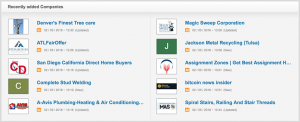Directory submission is a tactic that has evolved dramatically since it first became known. Firstly, it is no longer referred to as a directory submission, simply because the term has received some negativity over the years.
Secondly, the goals have changed: we no longer focus on link acquisition. When you come to think of it, the whole link-building strategy has undergone the same evolution: it has become more integrated, meaning that we now pursue non-link-building tactics while still hoping to get some links anyway.
Some of the non-link-building benefits of getting listed that may still result in links include:
- Proactive reputation management (i.e. making sure your business name is mentioned a lot across the web)
- Discoverability (i.e. making sure your business is there when people use the directory search to find what they need). This comes with traffic and leads, which is always nice.
Getting listed: the opportunities
If you think directories are dead, think again: there are plenty of new and old directories out there that can send you traffic and leads. Here are just a few categories to look into.
SaaS and B2B directories
Business directories
These come in several types and forms. Some are more traditional (free but with the option of charging you once for premium review):
While others charge you a monthly/yearly fee:
- Business.com ($299 annual fee)
- Tuugo.us ($9.99 per month for premium listing)
- Yalwa.com ($4.95 a month for premium listing)
Local directories
These deserve a separate article (which you can find here). Apart from the ability to send local traffic (from people trying to discover a local service), they are also quite useful for so-called local citation building – in other words, they help search engines associate you with important locations.
Getting listed: the smart way
There are many more useful directories out there that can still drive sales, but choose wisely; in many cases, it’s an investment of some sort. In addition, it’s paramount to stay away from penalized directories. Here are a few tools I use to evaluate whether any directory or platform is worth the investment:
Find whether the platform ranks in Google
Does Google think a directory is good enough to rank it high in search results? Search positions are the most reliable sign of a site’s health.
There are not many sites that will let you see the stats for free, and Serpstat is one of the most affordable.
Simply run the domain in Serpstat to quickly see where it ranks and how its rankings are distributed among different search engines. There are also tools to analyze whether the domain is ever featured in Google, which is an important signal of health too. Here is the list of tools you can use.
Find whether the platform has any traffic
Since creating an alternative traffic source is one of the main goals here, this is vital. There aren’t many reliable ways to evaluate a website’s traffic unless you own it, but these are decent:
- Alexa.com: its major data source is their own toolbar, which may mean it’s somewhat limited. Yet, it is the oldest player in the field, and therefore quite trustworthy
- SimilarWeb.com: read more about their data sources here: “global ISP data, and thousands of add-ons, extensions, apps and plugins, plus a team of web crawlers that scan thousands of websites”.
Check whether your subcategory is linked to from elsewhere
I wouldn’t be an SEO if I paid no attention to backlinks, but in my defense, links are not just a sign of SEO ‘authority’ – they signal quality too; if someone links to it, it must be a good page.
I use Ahrefs bulk backlink analysis feature to quickly run a lot of pages and section to choose the best ones.
[NB: I only mention directories that have proven worth the investment based on their rankings and traffic.]
Have you listed your website in some directories and seen some solid traffic and leads? Share your tips and resources in the comments.





